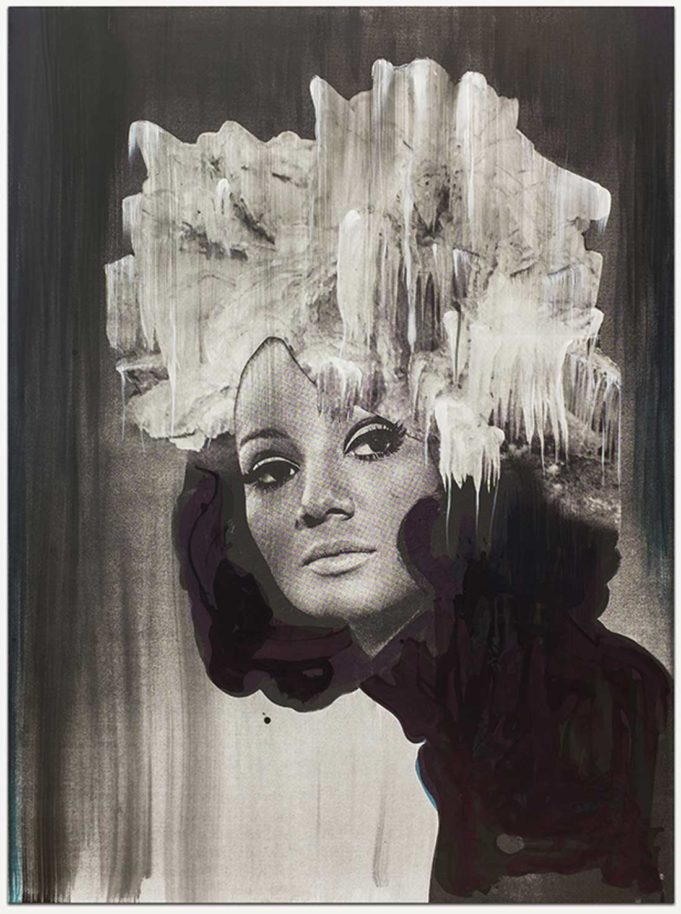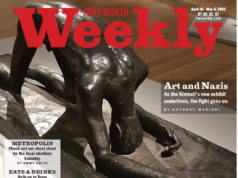The entry to FOCUS: Lorna Simpson is almost completely filled by a Madonna-esque diptych.
At 5-by-8 feet, “Famous Statue Damn” and “Famous Statue Volcano” depict identical figures with tilted heads and bodies in contrapposto, their gazes offering reassurance and comfort, even as they loom over the destructive forces of a flood and a volcano. The ink-and-screen printed images on wood panels feature a headshot of a smiling Ebony magazine wig model from the 1970s, superimposed on a picture of an unnamed nude female sculpture. Hash marks frame the headshots, forming crucifixes that connect the figures even more to the sacred.
The 10 paintings in this exhibition were all created in 2016, and they draw on earlier works and influences from Simpson’s 30-year career. In an interview with Modern assistant curator Alison Hearst, Simpson responds to Hearst’s observations about the socio-political themes in the work –– specifically her recent show at Salon 94, the artist’s New York gallery: “The personal is political, and that is very much present in the work, so I would say these recent pieces have this binary tension between my personal life and what it is for me to be American right now.”
It’s hard to reconcile those sentiments in these works without exploring the binary tension that African-American artists feel collectively, because it’s not readily apparent on the surface. On the one hand, we are encouraged as professionals to compartmentalize our lives into the personal and the professional, but they are inextricably connected because of the politics of race. We can’t undress ourselves of our skin. It is a part of who we are.
Simpson navigates this border in most of the paintings in the show, although more successfully in some works than others.
One particularly transcendent piece is “Shift.” Escaping the constraints of the abbreviated lexicon ascribed to artists of color, anchored by race and culture, the painting, on two panels, was installed with the left panel shifting slightly lower than the right, interrupting the solid iceberg at the center of the composition, as if it were breaking off and melting away.
This tectonic shift becomes a reflection of our times, when so much social progress built over decades seems to be breaking off and sliding away in the recurring current of social injustice on which we find ourselves adrift. But “Shift” is also imbued with a more universal context, speaking to themes of solitude, longing, and a more primal, if spiritual, internal landscape.
Other works in the gallery hint at the limited palette around which artists of color must maneuver. The deliberate contouring of splattered ink around cloud formations in “Black Nebula” forms a floating cotton blossom above a ladder that penetrates the composition from the bottom of the frame. The top right section of the 12-panel composition is rotated 180 degrees, creating an exit out of the scene and what could easily become the trappings of a limited lexicon.
An adjacent group of paintings resonate with the rest of the works in this show, mining culturally specific media images to create a stylized set of pieces reminiscent of Warhol’s Marilyn prints. In “Head on Ice” 1 through 4, each painting depicts the head of an Ebony magazine wig model topped with a different ice formation. Reading the works from right to left, the ice mass goes from a solid form, confidently borne by the first model, to varying degrees of melt and disintegration which threaten to engulf each subsequent model. In the same interview with Hearst, Simpson says, “There’s something about ice that has come into the work that indicates either freezing or endurance.”
I would go further and suggest that the paintings reveal an equal portion of perseverance. Simpson leaves just enough of the model’s face to declare, “I am still here.”
Simpson has limited herself to painting in a very small range of grayscale, from a rich matte black to a glossy black ink with only two or three shades of gray and a tinge of white in between. This effect complements the newsprint that is the source material for most of the paintings in this body of work, and it gives the exhibition a documentary feel.
Circling back to the “Famous Statue” diptych at the entrance, with their destructive backdrops, Simpson also said to Hearst, “Conceptually, this is in tandem with what I’m feeling emotionally but also to what, I feel, is going on politically: the idea of being relentlessly consumed.”
FOCUS: Lorna Simpson
Thru Jan 15, 2017, at the Modem Art Museum of Fort Worth, 3200 Darnell St, FW. 817-738-9215.












